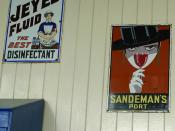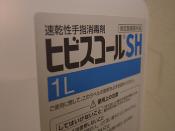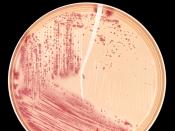Good Essay esp. for an investigation Good Intro to investigation
Investigating the antibacterial properties of a mouthwash
Introduction
The mouthwash under test id Asda Protect. It contains:-
÷ aqua
÷ alcohol
÷ glycerin
÷ polysorbate 20
÷ sodium benzoate
÷ aroma
÷ sodium saccharin
÷ cetylpyridinium chloride
÷ menthol
÷ sodium flouride (0.05%)
In this investigation we aim to test the antibacterial properties of this mouthwash treating
it like a disinfectant against three common bacteria which can be safely used in the
laboratory: Escherichia coli, Baccilus Megatherium, and Staphlococcus Albus.
Disinfection is a procedure which destroys, inactivates or removes potentially harmful
microbes- without necessarily affecting other organisms present; it has generally little or
no effect on bacterial endospores. Disinfection often refers specifically to the use of other
chemical agents (disinfectants) for the treatment of non-living objects or surfaces.
Ideally disinfectants for general use should be able to kill a wide range of common or
potential pathogens.
However, any given disinfectant is usually more effective against
some organisms than against others, and the activity of a disinfectant may be greatly
affected by factore such as dilution, temperature, pH, or the presence or organic matter or
detergent; to be effective at all, a disinfectant needs appropriate conditions, at a suitable
concentration, for an adequate period of time. Some disinfectants tend to be unstable, and
some need solubilization in order to be effective. At low concentrations some disinfectants
not only cease to be effective, they can actually be metabolized by certain bacteria
Dinfectants which kill bacteria are said to be bactericidal. Others merely halt the growth
of bacteria, and if such a disinfectant is inactivated - e.g. by dilution, or chemical
neutralisation - the bacteria may be able to resume growth; these disinfectants are said to
be bacteriostatic. A bactericidal disinfectant may become...


